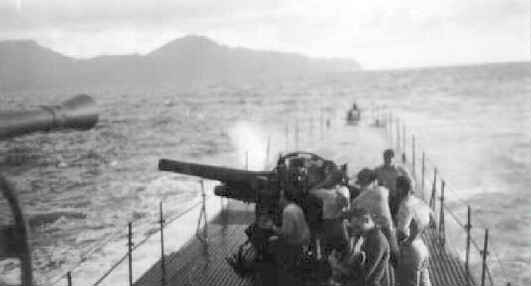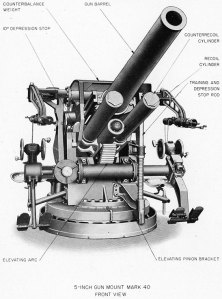Hunters of the Deep: A Brief Synopsis of the Contribution of the Silent Service of the Pacific
….. American memories of the WWII Asian battles usually dwell at Pearl Harbor, Guadalcanal, Iwo Jima and Hiroshima. As such, the majority of Naval dramatic action captured on film and in books occurred on the surface, on the beaches, or in the air, as the era witnessed an incredible shift from the battleship force to the aircraft carrier, its support units and amphibious operations of the Marines and sustaining naval units. Deserved and warranted is the appreciation of Americans to the carrier and amphibious arm of the U.S. maritime service for their courage and invincible spirit. But in the Pacific, brave American warriors waged another kind of war in the deep that led to a valiant American victory against Japanese transports, oil tankers, and the combat fleet. Submarine warfare was not only an important factor in the defeat of the Japanese, but crucial to the American cause.
On the Shoulders of Giants: Innovation and Courage – The Legacy of World War II Submarine Veterans
Shadow Warriors – Submarine Special Operations in World War Two
Rising to Victory, Part 1
Rising to Victory, Part 2
USN Submarine Warfare Against Japanese Shipping
USN Submarine Crewman 1941-45
The Gato Class Submarines
Surface and Destroy: The Submarine Gun War in the Pacific
Sub Uses Deck Gun to Sink Japanese Vessel
Aboard the USS Pollack in Pacific Ocean · March 11, 1942
On this date in 1942 the USS Pollack made the first submarine attack using only its deck guns. Its target were two Japanese fishing boats. During 1942 U.S. submarines reported 34 such attacks on sampans and trawlers. The number of attacks increased to 64 in 1943, the same year a U.S. Seventh Fleet bulletin put an official imprimatur on surface gun attacks. The July 30 bulletin advised that submarine gunfire could be effectively used against junks, schooners, and other small vessels. Their sinking over the long haul, the bulletin advised, would produce impresssive results. The Japanese, suffering mounting shipping losses to their merchant fleet, increasingly resorted to smaller craft to move personnel, supplies, and even heavy equipment between Pacific islands and along their own coast. Prisoners captured from junks confirmed that the Japanese were using such craft to ship rubber, timber, tin, rice, tea, and shark liver oil, which was used to lubricate Japanese aircraft engines. Typically owned by Chinese using a mixed crew of Chinese, Malays, and Indians, a 100-ton junk might carry enough rice to feed 2,000 Japanese soldiers for three months. Many submariners felt that attacking fishing craft, and hence Japanese food supplies, was entirely justifiable. When the submarine HMS Thule sank nine junks in a single day in December 1944, its British skipper claimed his actions had destroyed enough rice to feed 5,000 Japanese troops for months.
However, some skippers believed these close-range surface gun battles were “just too much”—“intolerably personal” in the words of one sailor—and so they declined to engage in these attacks. Whether to attack and sink these defenseless or lightly armed vessels remained a persistent dilemma, both moral and tactical, throughout the war even as the number of vessels sunk by deck guns rose. In 1944, the number of small craft destroyed climbed to 133, but declined in 1945 to 99 before hostilities ended in August. By war’s end most large Japanese fishing vessels in Southeast Asia had been destroyed in the context of “total war” against Japan.
The Deck Guns at ValoratSea.com
5″/25 caliber gun at Wiki
5-Inch Gun Mount Mark 40 at HNSA
<Click for the sound of a 5″ round>

Deck guns of the USS Bergall (SS-320)
